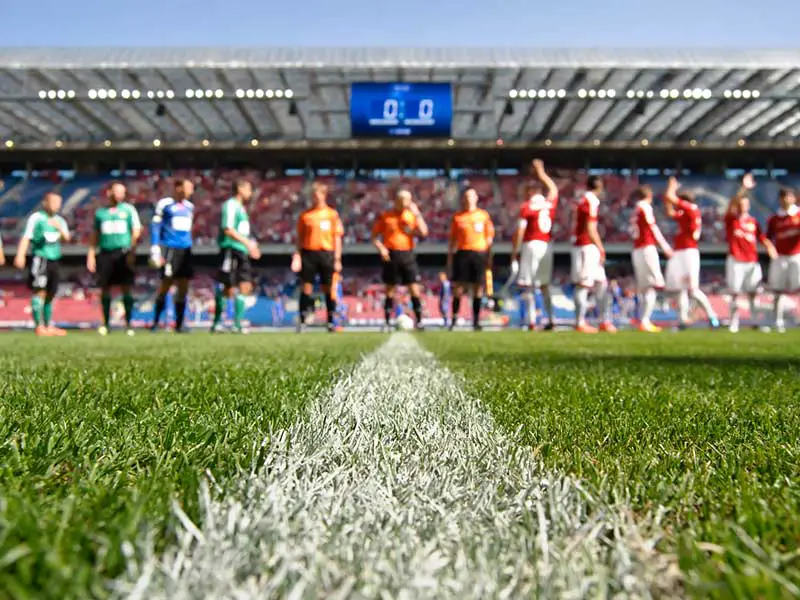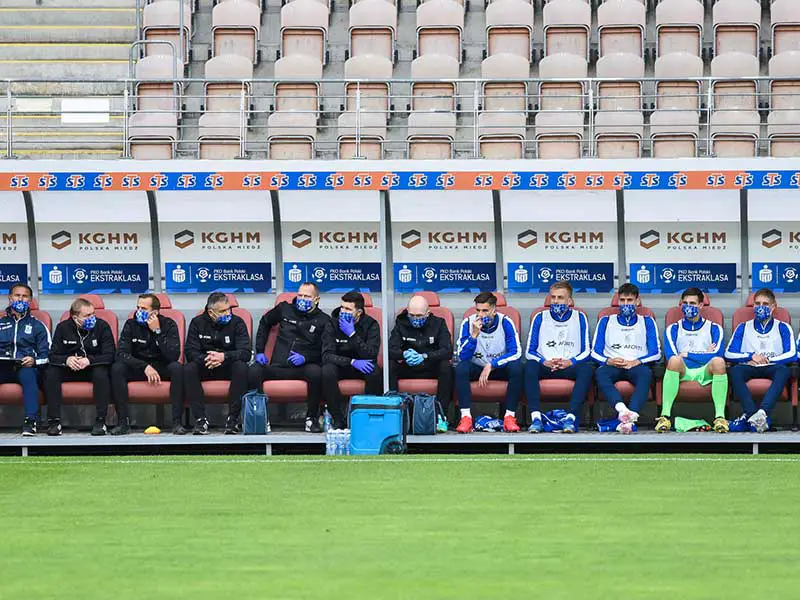How Many Players Are on a Soccer Team?
Soccer, also known as football in many parts of the world, is a popular sport played by millions of people of all ages. One of the essential aspects of this game is the number of players on a team. Although it might seem simple, understanding the standard number of players, positions, and variations in different leagues is crucial in grasping the game’s dynamics.
Each soccer team has 11 players on the field, consisting of a goalkeeper and ten other players which are referred to as ‘outfield players’. The outfield players are a mixture of defensive and offensive players.
On the substitutes bench, a team can have between five and seven players. The coach can use between 3 and 5 of these subs depending on the particular league regulations.
Substitution rules and player positions contribute to the overall makeup of a soccer team. Even though the composition may appear rigid, coaches often adjust tactics and formations to better utilize the strengths of their players. This flexibility allows teams to adapt, making soccer a diverse and exciting sport to watch and play.
The Basic Structure of a Soccer Team
A soccer team consists of 11 players on the field, each playing a specific role and position to help their team score goals and prevent the opposing team from scoring. This section will break down the basic structure of a soccer team into field players and goalkeepers.

Field Players
Field players can be further divided into three main positions: defenders, midfielders, and forwards. Each position has a critical role in both offense and defense, and the distribution of players among these positions is as follows:
- Defenders: Usually, there are four defenders on the team. Their primary duty is to protect their goal from the opposing team’s attacks and prevent them from scoring. Defenders often possess physical strength, good tackling skills, and a strong sense of positioning.
- Midfielders: A soccer team typically has three midfielders. They play a vital role in connecting defense and attack, controlling the tempo of the game, and creating goal-scoring opportunities. Midfielders must be versatile, as they contribute to both defensive and offensive plays. They need good ball control, passing skills, and vision.
- Forwards: The primary goal of the three forwards is to score goals or create scoring chances for their teammates. Forwards are often the fastest and most skillful players on the team, as they need to outsmart the rival defenders, create space, and accurately shoot the ball into the net.
Goalkeepers
The goalkeeper is a specialized position, and each team has one on the field. The goalkeeper’s main responsibility is to prevent the opposing team from scoring by saving shots, intercepting crosses, and organizing the defense. They are the only player allowed to use their hands and arms within the 18-yard penalty area. Goalkeepers need excellent reflexes, anticipation, positioning, and strong communication skills to excel in their role.
Overall, the basic structure of a soccer team is composed of 11 players, including field players and a goalkeeper, working together to achieve victory. Each position has specific responsibilities and requires unique skills to perform at the highest level.
Standard Number of Players on a Soccer Team
A soccer team consists of 11 players on the field at any given time. This includes one goalkeeper and ten outfield players. The outfield players typically consist of a mix of defensive and offensive positions, such as defenders, midfielders, and forwards.
The standard formation for a soccer team involves four defenders, three midfielders, and three forwards. However, formations can vary depending on a coach’s strategy and the team’s requirements. Teams have the flexibility to change their formations based on their opponents or specific game situations.

In addition to the 11 players on the field, teams usually have substitute players on the bench. These substitutes can be used to replace injured players, or as tactical adjustments during a match. Most professional leagues allow for a specific number of substitute players on a team’s roster. For instance, Major League Soccer (MLS) allows 30 players per squad, while the English Premier League, Bundesliga, La Liga, UEFA Champions League, and UEFA Europa League limit squads to 25 players.
During matches, the allowed number of substitutions can vary among leagues and competitions. For example, the MLS permits five substitutions per team per match, whereas other major leagues like the English Premier League only allow three substitutions per team per match. These substitutions provide coaches with the opportunity to adapt their tactics throughout the course of the game.
In youth soccer and non-elite adult leagues, the number of players on a team and allowed substitutions may differ from professional standards to accommodate the needs of the participants and ensure fair competition.
Substitution Rules
Soccer is a game that requires a balance between playing time and player fatigue. To maintain this balance, substitution rules exist to allow teams to replace tired or injured players during a match. In professional soccer, teams are permitted to make up to five substitutions throughout the course of a game. These rules are in place to prevent excessive interference with the game and to ensure fair play.
Substitutions are typically made when a player becomes fatigued or injured, or when a coach decides to change their team’s strategy. The substitution must occur during a stoppage in play, and with the permission of the referee. Players who have been substituted are not permitted to re-enter the match.
In professional leagues and tournaments, teams can name up to 12 players as substitutes on their bench. This allows coaches the flexibility to select from a range of players to replace those on the field. The process of naming substitutes varies by league or tournament, but generally includes five to 12 players, depending on the specific rules in place.
In addition to the standard five substitutions, some competitions allow a sixth substitution during extra time. This helps teams manage player fatigue during extended matches, which can last 30 minutes or more beyond the standard 90-minute game length.
It’s important to note that substitution rules may vary slightly across different leagues and tournaments. However, the fundamental principles remain consistent – substitutions aim to maintain the balance between player fatigue and fair play while giving teams the flexibility to strategically manage their players on the field.
Player Positions and Roles
In soccer, there are 11 players on a team, including the goalkeeper. The remaining 10 players are divided into various positions on the field, with each position having a specific role to fulfill during the game. This section discusses the main soccer positions and their roles, categorized into defenders, midfielders, and forwards.
Defenders
Defenders are responsible for protecting their team’s goal and preventing the opposition from scoring. They are focused on stopping the opponents’ attacking players and intercepting passes. The defenders are categorized into the following positions:
- Center Backs (CB): These players are positioned at the center of the defense, usually as a pair. They are responsible for marking and tackling the opposition’s forwards. They are also strong in aerial duels.
- Fullbacks (RB & LB): These players operate on the right (RB) and left (LB) flanks of the field. Their primary responsibility is to defend against the opposition’s wide players and provide support to their team’s midfielders and wide forwards.
Midfielders
Midfielders are integral to a team’s control of the game. They are responsible for creating scoring opportunities and supporting the defense. Midfielders can be further divided into the following positions:
- Defensive Midfielder (DM): Positioned in front of the defense, the defensive midfielder helps shield the backline and break up the opposition’s attacks. They also help retain possession and start the transition from defense to attack.
- Central Midfielder (CM): These players are positioned in the center of the field. They have a range of responsibilities, including passing, tackling, shooting, and creating scoring opportunities.
- Attacking Midfielder (AM): The attacking midfielder is the creative force behind the team’s attack. They are responsible for providing assists, scoring goals, and linking up with the forwards to create scoring chances.
- Wingers (RW & LW): Positioned on the right (RW) and left (LW) sides of the field, these players use their speed and dribbling skills to beat defenders and cross the ball to their teammates in the box.
Forwards
The primary role of forwards is to score goals and capitalize on chances created by the midfielders. Forwards can be categorized into the following positions:
- Striker (ST): The main goal scorer on the team, the striker must finish attacking moves, hold the ball up, and create chances for their teammates. They have strong finishing abilities and positional awareness.
- Second Striker (SS): Positioned behind the main striker, the second striker supports the attack by creating space for the main striker and providing assists with passes or by shooting themselves. They possess excellent vision and technique.
These positions and roles combine to make soccer a complex and fascinating game that requires teamwork, strategy, and skill.
Youth and Amateur Soccer Team Sizes
In youth soccer, the number of players on a team varies depending on the age group. For players under the age of 8, it is advised to have 5 players on each team. As players get older, the team size increases. For the U9 and U10 age groups, there should be 7 players per team. In the U11 and U12 age groups, 9 players per team are recommended. Finally, for players in the U13 to U16 age groups, the standard 11 players per team applies.
Some youth soccer organizations use smaller-sided games for younger players to focus on skill development and increase their touches on the ball. In these formats, there may be no dedicated goalkeepers, and the number of players on the field can be as few as four for under-7 and under-8 age groups.
Moving on to amateur soccer at the high school and college levels, the number of players on a team typically adheres to the standard formation, which consists of 11 players on the field at one time. This formation includes one goalkeeper, four defenders, three midfielders, and three forwards. However, coaches may alter the formation based on their team’s specific requirements, strategies, or the strengths of their players.
In addition to the starting 11 players, a soccer team may also have substitutes on the roster. The number of substitutes can vary depending on the league and competition rules, but they generally range from three to seven. These substitutes are essential for maintaining the team’s stamina and performance throughout a game, as they can replace fatigued or injured players.
To summarize, the size of youth and amateur soccer teams varies based on age group and competition level. Younger youth teams have fewer players on the field, while high school and college teams follow the standard formation of 11 players on the field at a time.
